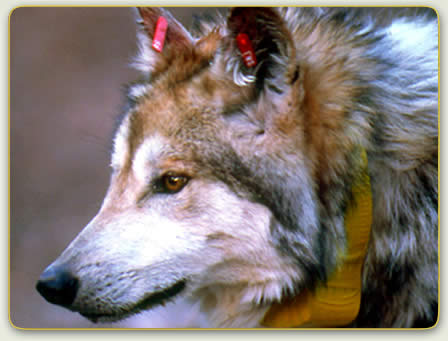Newly collared wild-born Mexican wolf adds to wild population
 U.S. Fish and Wildlife Service
U.S. Fish and Wildlife Service
News Release
Public Affairs Office
PO Box 1306
Albuquerque, NM 87103
505/248-6911
505/248-6915 (Fax)
Contacts: Tom Buckley, 505-248-6455, Tom_Buckley@fws.gov
Bruce Sitko, 928-367-4281. bsitko@azgfd.gov
PHOENIX — Members of the Mexican Wolf Recovery Program, Interagency Field Team (IFT), recently captured and collared a young adult wolf as part of the ongoing recovery program for endangered Mexican wolves. The capture of this animal occurred on the San Carlos Apache Reservation. An agreement between the U.S. Fish and Wildlife Service (Service) and the the San Carlos Apache Tribe requires removal of wolves from their tribal lands. The wolf was translocated and released nearby on adjacent National Forest lands within the Blue Range Wolf Recovery Area (BRWRA). San Carlos Apache Reservation is not within the boundary of the BRWRA.
The wolf was captured in close proximity to the Rim Pack, fitted with a radio telemetry collar, and released into the BRWRA on March 8, 2011. Mexican wolves are given an identification number recorded in an official studbook that tracks their history. This female wolf was assigned number F1213 and is believed to be wild-born. Samples were collected from F1213 and have been sent in to the Service’s Forensics Laboratory in Ashland, Oregon, to determine its parentage and pack affiliation.
After several days, the wolf was documented travelling alone within the traditional territory of the Rim pack south of the Mogollon rim in Greenlee County. The IFT continues to monitor this wolf to determine if it is part of the Rim Pack.
Every January, the recovery program partners conduct ariel surveys to assess the wolf population in the Arizona-New Mexico reintroduction area. These surveys, coupled with observations made by the IFT in November and December, provide the total number of wolves observed in the wild. This annual wolf count represents a minimum number, as there is always the possibility individuals are not factored into the population count because they weren’t located. The minimum population estimate for 2010 was 50 wolves in the wild.
The Arizona Department of Game and Fish estimates that approximately 90 percent of the free-ranging wolves in Arizona were born in the wild. Biologists believe that wolves that have been wild for several generations are the key to the long-term success of the wolf project.
Mexican wolf recovery is a joint effort by the U.S. Fish and Wildlife Service, Arizona Game and Fish Department, New Mexico Department of Game and Fish, White Mountain Apache Tribe, USDA Forest Service, USDA Animal and Plant Health Inspection Service – Wildlife Services, and other local stakeholders.
The mission of the U.S. Fish and Wildlife Service is working with others to conserve, protect and enhance fish, wildlife, plants and their habitats for the continuing benefit of the American people. We are both a leader and trusted partner in fish and wildlife conservation, known for our scientific excellence, stewardship of lands and natural resources, dedicated professionals and commitment to public service. The U.S. Fish and Wildlife Service works cooperatively with the American public to continue the conservation legacy of America’s great outdoors. For more information on our work and the people who make it happen, visit http://www.fws.gov/southwest/.
To learn how to help keep this and other endangered Mexican gray wolves protected, visit our Activist Toolkit.



